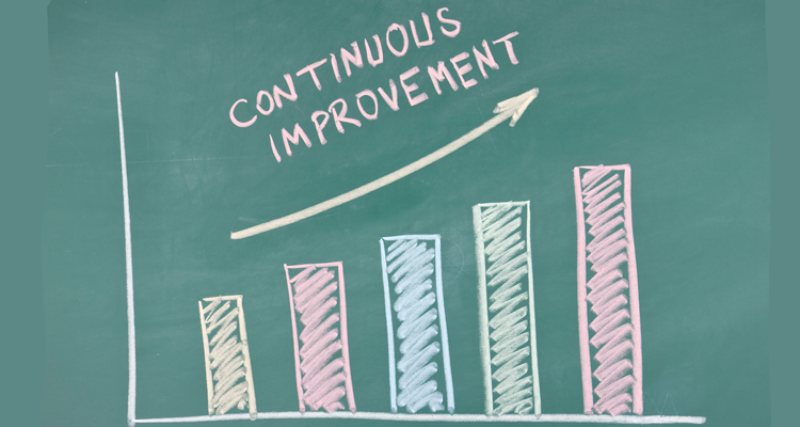
Spring is a time of renewal; a time to clear out the old to make space for new opportunities. If you’re using a Kanban board to manage your team’s work, you probably do some regular maintenance to keep your Kanban board up-to-date. However, just like with the closets in your home, from time to time, you might want to do a deeper clean to clear out some of the mental ‘cobwebs’.
If your Kanban board has been feeling cluttered by all the unfinished tasks of the past few seasons, it might be time to do a little spring cleaning. Here are three reasons why you should consider giving your team’s Kanban board a deep clean this spring, and anytime you need a refresh.
#1 Spring into continuous improvement
Do you feel a sense of momentum going into the spring season? Are you feeling energized by the idea of new projects, ideas, and initiatives (and warmer weather)?
When you open your Kanban board to put them into action: Does the momentum continue, or do you feel stunted? It can feel hard to make big changes when you’re tied to a foundation that feels set in stone. Sometimes it’s easier to start from scratch with a blank, fresh board, full of opportunity. If your big ideas for the new year aren’t fitting into your old board, it’s probably time to rebuild it to meet your new needs.
Building your board anew can help you discover new opportunities for continuous improvement. But don’t lose the progress you’ve made thus far by abandoning your old board completely!
Before you start dismantling your board, take some time to note what is working about its current configuration. Get your team together and discuss topics like:
- What lanes and swim lanes have been helpful to your team?
- What insights have you been able to glean from your board metrics?
- Are there any process policies that your team has found useful?
- Have WIP limits made a big difference in your team’s efficiency?
While some teams prefer to have an unstructured discussion about board design, others like the more formal approach of a retrospective or Lean coffee. What’s important is that you gather perspectives from across the entire team—not just a few members.
#2 Clean out the (mental) cobwebs
Just like taking down holiday decor and cleaning out your pantry can help you usher in the new year at home, burning your board can help you get a fresh start in the spring season. Whether you decide to start a new Kanban board from scratch, or simply spend some time archiving/deleting cards on your existing board, a little spring cleaning is almost always a productive use of time.
Throughout the year, your team likely creates cards to represent ‘nice to haves’ or ‘someday’ tasks. If you still fully intend on prioritizing and completing them, these cards might have a home on your new board. But if you don’t, they might be clogging up your team’s cognitive space, inhibiting everyone’s ability to focus on what’s important (even if subconsciously).
That’s because extra, unprioritized cards on your board don’t just cause visual clutter–they also occupy cognitive space. When you see a card on your board, you probably spend a few moments thinking about that task, even if it’s not necessarily relevant to your current goals or priorities. You see the card, you think to yourself, “Oh yeah, we talked about doing that,” and then move onto trying to figure out what you actually need to be focusing on.
Less senior members on the team might feel particularly encumbered by cards in the backlog with their ‘face’ on them, since they might not feel that they have the authority to decide not to do them. But if a card is assigned to you, but hasn’t been prioritized, what do you do about it?
With a clean board, you can start by bringing in what is top of mind now–not what sounded like a good idea six months ago, but might not be as valuable anymore.
#3 Sweep away distractions
Cleaning out your board (or burning it down completely) can also help your team get a more accurate understanding of WIP–a key component of practicing continuous delivery.
If you have a bunch of half-conceived ideas clogging up your Kanban board, your team might feel like they’re at capacity, even if they aren’t. It’s hard to get excited about adding new cards to the board when the board already looks full.
Taking some time as a team to review and make decisions about the cards you have in your backlog can be a cathartic exercise for everyone on your team. Talking through what is and isn’t a priority, and why, can be a great way to energize your team for the future. It can give the members on your team a refined sense of clarity around what’s actually important, what’s coming up, and what ideas they can lay to rest, helping everyone stay focused on delivering more value.
Tidy up your team’s process
Even if your pantry is immaculately organized, the food inside can still go stale. Similarly, even if your Kanban board is functioning, there might be parts of it that are no longer serving you—in order words, they’ve passed their expiration date in terms of usefulness.
Taking some time to do a little spring cleaning on your Kanban board can give your team an opportunity to think critically about what’s propelling growth, and what’s just getting in the way. It’s easy to think of Kanban board design as a ‘one and done’ kind of thing—but as your team evolves and grows, your Kanban board should evolve and grow alongside it.
Usher in a new season of growth by cleaning out the cobwebs of past seasons. At the very least, you’ll start a conversation with your team about the process you’re following, which is an organic way to inspire continuous improvement efforts across your team.
To learn more about how Kanban can help your team regain focus and reach new levels of efficiency and performance, we recommend the following resources:






